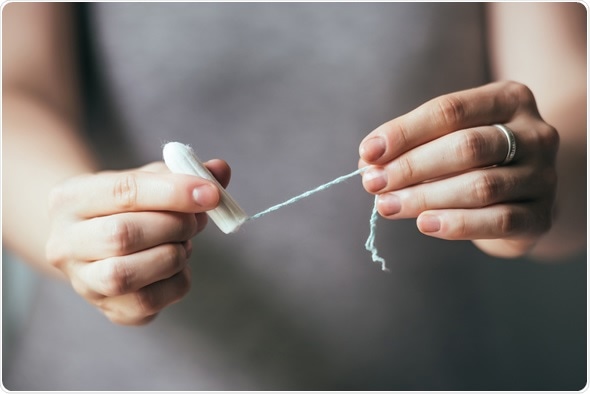How To Get A Tampon Out
When a woman finds a tampon has become stuck or "lost" after insertion, this is referred to as a retained tampon.
This might happen as a result of inserting a new tampon before removing the previous one, engaging in intercourse while a tampon is still in, or by forgetting a tampon is inserted when the end of a period is reached.
Since the vagina is quite an elastic canal, having intercourse while a tampon is in or inserting a second tampon is possible. The tampon may then turn sideways inside the vagina and become compressed at the top of the vagina, near the cervix. The cord that usually stays outside of the body can get drawn in, making it difficult to remove the tampon. If a woman forgets to remove a tampon once her period has finished, the same can happen, although the cord may still be visible.

Cotton tampon - Image Copyright: Yulia Grigoryeva / Shutterstock
It is not possible for a tampon to become "lost" inside the abdomen. The tampon stays at the end of the vagina, next to the cervix. The cervix has a tiny opening through which blood and semen can pass, but this opening is too small for a tampon to pass through.
Toxic Shock Syndrome
The tampon itself can also not cause any damage to the vagina or cervix. The main concern in the case of a retained tampon is an infection referred to as toxic shock syndrome.
Toxic shock syndrome is a rare, but potentially dangerous bacterial infection caused by Staphylococcus aureus and Streptococcus pyogenes. These are bacteria that are usually present on skin, nose, or mouth, where they live without causing any harm. However, they can enter the bloodstream and release toxins that cause damage to the skin, organs, and other tissues.
Although it is possible for a tampon string to get drawn into the vagina, it is still often possible to feel the tampon, grasp it, and remove it. However, if this is not possible, a healthcare professional at a GP practice or sexual health clinic will be able to remove it.
In some cases, a woman may not be sure whether a tampon has become retained or not. The following are signs that this may have happened:
- Yellow, green, brown, pink, or grey vaginal discharge
- Foul smelling discharge
- Foul smell, but no discharge
- Vaginal itching
- Vaginal swelling
- Vaginal rash
- Reddening of the skin in the genital region
- Fever
- Discomfort or pain when urinating
- Abdominal or pelvic pain
If any of these symptoms have developed, it is not advised that a woman tries to remove the tampon herself and medical attention should be sought.
Guidelines advise that a tampon should not be left inside the body for more than eight hours. If a tampon has become retained and a woman has none of the symptoms mentioned above, she may wish to try removing the object herself by following the steps outlined below:
- Ensure hands are clean to prevent any bacteria entering the vagina and cover any cuts or scratches on the hands.
- Sit on a toilet seat with the feet positioned on something approximately a foot high and push, as is done during a bowel movement or when giving birth. This can help the tampon move down the vaginal canal.
- Place a finger in the vagina, making circular movements and reaching as far inside as possible. Try to reach the area at the top of the vagina where the tampon is likely to be lodged. If the tampon can be detected, try to insert two fingers to grip the tampon and pull it out.
If it is still not possible to remove the tampon, assistance should be sought from a nurse or doctor. The following steps would then be followed.
- The woman is asked to lie on her back with her legs spread
- The outside of the vagina is examined
- A speculum is placed inside to open up the vagina so that it can be viewed under direct light
- Usually, the tampon will immediately be spotted and removed using a clamp
- The vagina is examined for any signs of damage or infection
- If symptoms of infection are present, antibiotics are prescribed
Further Reading
- All Primary Care Content
- What is Primary Care?
- Primary Healthcare Providers
- Physician Shortage
- Challenges in Primary Care
How To Get A Tampon Out
Source: https://www.news-medical.net/health/How-to-Remove-a-Stuck-Tampon.aspx
Posted by: mccrayroolearm.blogspot.com

0 Response to "How To Get A Tampon Out"
Post a Comment